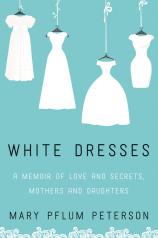Reading Group Guide
Discussion Questions
White Dresses: A Memoir of Love and Secrets, Mothers and Daughters

1. “I think of white dresses as a way of starting over. They’re sort of a way of wiping the whole slate clean. Just like what happens in the wintertime when the snow comes. It wipes away everything in preparation for a new year, a new spring.” Anne tells a young Mary that white dresses are often worn to “start over…white is great for beginnings.” In what way do each of the dresses in WHITE DRESSES signify a beginning for Anne and Mary?
2. Aurelia, Anne and Mary all share a love for reading and writing. What role do literature and writing play in each of their lives? At what points in their lives do they turn to books for solace or escape? In what ways does their shared passion help bring them together?
3. Anne confesses that one reason for her hoarding is that she wanted to find a way to make the house into something that was truly hers, while Mary resented that the mess made her childhood home no longer feel like it belonged to her. What is the importance of having a place that belongs to you? Why is it so difficult and painful to have these places taken away?
4. Anne’s childhood blanket is described as her “one true constant,” and the idea of having a constant comes up multiple times throughout WHITE DRESSES. What is the importance of having something solid you can count on during times of change? In what ways do the characters hold onto constants throughout the story?
5. “From the time she was old enough to read, Anne Diener had craved every bit as much the unconditional love of a dashing suitor as she did the affection and approval of a mother she couldn’t seem to reach.” In what ways did Anne’s frayed relationship with her mother spark her desire for unconditional love? How does this desire eventually lead her to join the convent, and what effect does it have on her relationship with religion?
6. Although WHITE DRESSES focuses primarily on the relationships between parents and children; Anne, Mary and Dale also have complicated relationships with their siblings. What are each of these relationships like, and how do they reflect or influence their family dynamics? Do the relationships continue to affect them as they grow older, and if so, how?
7. Anne sees two options for her life: join the convent, or become a wife and mother. What does this say about society’s view of women at the time? How much of this thinking stems from Anne herself, and how much is influenced by the culture she lives in?
8. “The dress was so pure. If only life could be as unblemished. How delicious that would be --- to feel as perfect on the inside as this dress appeared on the outside.” In what ways do the characters in WHITE DRESSES rely on creating “perfect” outsides to mask their unhappiness and troubles? How effective are they in doing so? How does this keep them from opening up to others, even to the people closest to them?
9. “Trust me on this one, sweetheart: stick with those who understand life is all gray and that most of us are, too. The people who see the gray are more fun anyway.” In what way have Anne’s past experiences and family history allowed her to see past the black and white way that others see the world? How does this way of thinking help her forgive more easily and understand people better? Does Mary inherit her mother’s same ability?
10. How do different characters in WHITE DRESSES define “home,” and how do their ideas on the subject differ from each other? What is the importance of home in the book?
11. “Every child reaches that point when he or she realizes the parent is fallible.” Compare the two moments when Mary and Anne first come to see of the fallibility of their respective mothers. To what extent do these new realizations alter their mother-daughter relationships? Why is the realization that their parents are imperfect such a monumental event for children?
12. “Her philosophy: something good could always come out of something bad.” Which characters best exemplify this life philosophy? In what ways is the very act of writing WHITE DRESSES itself an attempt to make “something good come out of something bad?”
13. For all the white dresses they own, Mary never wears any of Anne’s old dresses; even at her baptism she wears a dress passed down through her father’s side of the family. Why is it significant that although white dresses are something they have in common, they each have their own, separate dresses?
14. Why does Anne continue to have faith in the church even after it has rejected her more than once? Are we meant to respect her for her unwavering devotion or find her faith misguided? How does her faith influence other aspects of her life?
15. In what ways is Anne’s parenting style and her relationship with her daughter a response to her relationship with her own mother? How is she trying to avoid making the same mistakes her mother did? How is Anne trying to keep Mary from making the same mistakes she made?
White Dresses: A Memoir of Love and Secrets, Mothers and Daughters
- Publication Date: September 15, 2015
- Genres: Autobiography, Biography
- Paperback: 352 pages
- Publisher: William Morrow Paperbacks
- ISBN-10: 0062386972
- ISBN-13: 9780062386977








